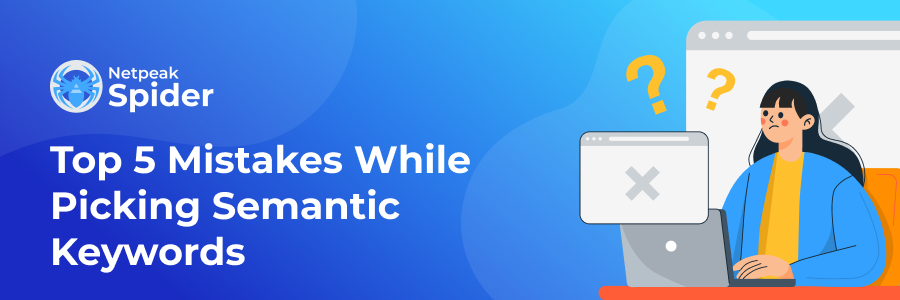5 Common Mistakes in Picking Semantic Keywords
How to
Creating a semantic core is one of the essential stages of promoting an Internet resource. Every SEO specialist should know how to competently gather the semantic core based on the site's structure to build a promotion strategy and get to the top of the search results.
In this post, we will analyze the five main mistakes made by specialists at the initial stages of their careers while gathering semantic keywords.
What are semantic keywords?
Semantic keywords are words or phrases conceptually related to a given keyword or topic. For instance, "paella" and "Madrid" are semantically related to "Spain."
But don’t confuse semantic keywords with the target ones (i.e., the keywords you want to rank for). For example, you might want your web page to rank for "Spanish paella recipe" and related keywords like "how to cook Spanish paella." However, you probably wouldn’t want it to rank for just "Spain."
Another common misconception is that some people can refer to semantic keywords as LSI (a.k.a. latent semantic indexing) keywords — the term is inaccurate, and you shouldn't use it in this essence.
Why use semantic keywords in SEO?
Semantic keywords are essential in SEO. They help search engines understand your content and provide insight into its depth and scope. This information allows Google and other search engines to rank your page more accurately.
Algorithms analyze a web page to see if it contains relevant content beyond a given keyword, like pictures, videos, etc. So, for example, if we're talking about Spanish foods, Google might search for relevant images of paella or tutorials (videos, step-by-step guides, and so on).
Enriching your content with semantically similar words also improves its quality. You can cover relevant subtopics (e.g., Spanish desserts) and write more naturally using varied language. In return, it increases search engine rankings and user engagement rates.
How can you find semantic keywords?
Some of the most popular ways to find proper semantic keywords for your website include the following:
- Google Search
- Google Trends
- Google’s Keyword Planner
- Social monitoring tools
Google Search
You can often find semantically similar words in Google's SERPs. Here, pay special attention to the following elements when they pop up:
- Related searches. Google displays related search queries that refine your search. They can be an excellent inspiration for your semantic core.
- Bolded terms. In addition to highlighting the search term in bold, Google can point out related terms in snippets.
- People also ask. This box is an additional element in search results that contains popular questions and answers from across the web.
All these elements are an excellent source for semantic and question keywords.
Google Trends
You can also explore a topic or subject in Google Trends to find related search terms and queries. Enter a search term and select a relevant result from the list. Then, select the region and the time range you'd like to study.
You'll see the "Related topics" and "Related queries" tabs, where you’ll find semantically related words. The "Rising" section displays topics and queries with the most significant relative increase in search popularity over the defined time range. The breakout metric shows an increase of over 5,000%.
Finally, the "Top" results show the most popular relevant topics and queries. The most searched result has a score of 100, while the rest have a relative score (e.g., a query with a score of 50 is half as popular).
Google’s Keyword Planner
Google Ads has the Keyword Planner tool that provides access to semantically related keywords. To find them, launch the tool and click "Discover new keywords." Type a keyword into the search panel to get a list of related keywords and valuable insights like monthly search volume.
Google also offers valuable features like search filters to include or exclude specific terms based on various attributes. Thus, you can hide terms featuring brand names. This list lets you detect the most common search terms related to your initial keyword and better understand your niche's common types of searches.
Social monitoring tools
With social monitoring tools, you can easily track customer conversations on social media about topics related to your niche or business.
With these tools, it’s possible to set up alerts that inform you when people discuss the topics you write about. Thus, you can gather ideas for semantic keywords afterward. You can also follow hashtags or find relevant keywords directly on popular platforms.
5 common mistakes in picking semantic keywords
Now that you know what are semantic terms in SEO, let's explore the most common mistakes to watch out for when gathering these keywords for your website or article.
Using only one source

Many inexperienced SEO specialists use only one service to define keyword frequency, such as Wordstat from Yandex. That’s a mistake because wordstat.yandex works for keywords used solely in Yandex. Also, its sample is pretty limited. It results in losing many keywords at the initial promotion stage (from 40% to 80%). For an extended collection of semantics, it’s better to use at least 2-3 services, such as the following ones:
- Serpstat is a service that analyzes keywords and backlinks. It lets you collect the semantic core and analyze competitors. One of Serpstat’s critical features is that it discovers occurrences of popular words used when searching for keyword phrases (which is also beneficial for editors).

- Wordstat.Yandex is a free service from the Yandex search engine. It collects the frequency of keywords to assess users' interest in a particular topic. Also, Wordstat.Yandex works well with regionality. It’s advantageous when looking for frequency queries in a specific region of a country.

- Google Adwords is similar to Wordstat from Yandex but designed for Google. The critical disadvantage of the service is that it requires an active advertising campaign. However, there is also a significant benefit—adding negative keywords when analyzing.

Lack of query clustering or incorrect grouping

Many specialists without experience don't group the keywords when gathering a semantic core. Thus, they may face queries leading to a page that doesn’t correspond to the keyword.
In some cases, such a mistake doesn’t lead to poor results. However, if you keep repeating it with large online stores or other significant projects, it may result in keyword cannibalization.
Use various services, like the Serpstat Clustering tool, to group the semantics quickly. With this service, you can effectively form and spread clusters on the necessary website pages. In turn, the frequency indicator comes in handy when analyzing which clusters are worth promoting.
3. Collecting only high-frequency keywords

Some SEO specialists add only high-frequency keywords to the semantic core to quickly gain lots of organic traffic. This approach is inaccurate because it makes promotion much more challenging. A young project may fail to compete with established leaders. The situation is the opposite with low-frequency queries. You can create better, optimized content based on your competitors. Thus, you have every chance of getting into the top 10 results much faster and boost project promotion.
Let's look at high, medium, and low-frequency queries on the example of the topic "Movies."
- In this topic, high-frequency queries are from 50-100 thousand per month and more.
- Medium-frequency queries have nearly 5 to 50 thousand impressions per month and include additional keywords ("free," "2023-2024", "good quality," and others).
- Low-frequency queries that gain less than 1000 per month. But it’s also worth considering them when collecting a semantic kernel to expand the site's structure. Such queries include the words like "indie," "comedy," "HD," "720p," and others.
Keywords not verified in the search results

Beginner SEO specialists often add commercial and informational queries to the semantic core of one landing page. You can promote them if your page is informative but with a commercial intent. It means you can provide a specific service (for example, "Diploma writing" or "Exam preparation.") However, promoting an online store is impossible.
It’s necessary to separate informational and commercial requests clearly. This way, you don’t mislead the search robots that scan the site and index it for the desired query. If you have doubts about what intent refers to a query, check Google's search results to avoid such mistakes. For instance, the "conveyor belt" query is informational if you search for it without additional commercial intent. But it’s commercial if you add "buy" or "sell" to it.
Neglecting informational queries when collecting commercial ones

In my experience as an SEO IM, I have often noticed that people neglect informational queries when shaping the semantic core for commercial topics. I often made this mistake when throwing out informational queries instead of saving them in a separate file or table.
Of course, you can’t use such queries to promote the landing page of a product category or service. But you can use them to write blog posts, for example. It increases the keyword volume on the site and boosts the organic traffic.
Finally, it’s worth noting that the semantic core is a crucial stage of website promotion at the initial and later stages. Many SEO specialists say it’s a process without a certain deadline – and that's quite right. In this case, we can never fully complete the keyword-gathering process. However, remember that keywords affect the promotion and overall optimization of the site, its design, and security.
Run an SEO audit with Netpeak Spider
If you need to check whether your website performs well with the semantic keywords you've prepared for it, Netpeak Spider is your go-to app. With this tool, you can monitor your website's key metrics in real time, download crawling results conveniently, and integrate data from other SEO tools for in-depth data research.
On top of that, Netpeak Spider is super easy to work with. Here's how to start crawling in a few simple steps:
- Paste the URLs you need to check from a clipboard into the search bar.
- Select the metrics you want to analyze.
- Click "Start" to launch the crawling process.
And there’s more! Let’s look at some of Netpeak Spider's key features:
Data filters and segmentation

Netpeak Spider segments and breaks down the research data into categories. Thus, you can select the parameters you need to analyze simultaneously. An interactive dashboard provides access to customizable filters, letting you change the data overview mode for more convenient usage.
Internal PageRank calculator

The PageRank calculator is a handy feature that monitors each page's internal linking, link weight distribution on any page, and the link equity your pages use or don't get.
Integrations with Google Analytics and Search Console

Retrieve stats from Google Analytics and Google Search Console to enrich the research results. You can also receive essential insights on traffic, your page goals, conversion, and other key eCommerce parameters.
Check URLs for SEO parameters with Netpeak Checker
As mentioned earlier, regular checkups streamline your website's performance and ensure your semantic core is high-performing. And again, Netpeak Checker comes in handy. This powerful tool offers many features and enables integrations with various SEO-related services. Here's what else you can do with Netpeak Checker:
Integration with 25 other services to analyze 450+ parameters

Netpeak Checker enables integrations with 25+ SEO services, including Moz, SimilarWeb, Ahrefs, Serpstat, Google Analytics, and more.
50+ on-page parameters

Netpeak Checker delivers research results in an interactive dashboard. Here, you can monitor redirects, titles, response time, status codes, mobile-friendliness, etc. Just choose the required parameters and hit "Start."
Website traffic estimation

Netpeak Checker shows the traffic volumes on a target page, potential link-building donors’ share ratios, and traffic by location. Moreover, it highlights the types of traffic prevailing on a given page (search, organic, direct, mail, social, etc.).
Batch Core Web Vitals checkup

Retrieve data from Google PageSpeed Insights to analyze your website's loading speed, responsiveness, and visual stability.
Integration with Google Drive & Sheets

Connect your Google Drive account to Netpeak Checker. Quickly export any report to Google Sheets and share it anytime.
Final thoughts
Consider all the nuances and opportunities mentioned in this article to shape a semantic core for your website.
- Don’t throw out keywords similar to the topic but not adequately optimized for your website. Such keywords can expand the site structure and further promote it.
- Use the maximum number of available sources to collect the keywords.
- Check search results. Even experienced specialists can make mistakes when adding a query to the page's semantics.
Thus, the sooner you start applying the tips and correcting the mistakes described in this post, the easier it will be to develop a competent promotion strategy. As a result, you will be able to successfully and, most importantly, qualitatively implement the plan conceived.
Share what mistakes you've made while gathering a semantic core in the comments to this post. :)



